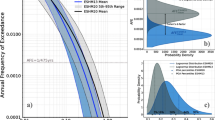Abstract
Iran is located in a very high seismic zone. The current national code of design of buildings referred to as Standard No. 2800 (STD-2800) employs the design-basis earthquake (DBE) based on the uniform hazard philosophy. New generations of seismic codes and related researches have used a uniform risk philosophy instead, where the parameters are defined in order to provide a tool for designing the buildings with equal or at least harmonized collapse probability across the country. In this paper, a risk-targeted seismic design map has been developed for Iran. A seismic hazard model developed by EMME14 project was used for this purpose. A generic collapse fragility function was used, the parameters of which were selected based on sensitivity analyses. Taking into account the seismic hazard model from the EMME14 project, the risk of collapse of the buildings in Iran was calculated once for DBE values provided by STD-2800 and again with the DBE values resulted from the EMME14 model. An acceptable risk level of 1% in 50 years was considered then, to estimate the map of distribution of risk coefficients as well as the map of collapse risk for the buildings in the country. The results show a large dispersion in the risk of collapse across the country, in both cases. Finally, the risk-targeted seismic design map for the country is presented.







Similar content being viewed by others
References
ASCE (2005) Seismic design criteria for structures, systems and components in nuclear facilities. American Society of Civil Engineers, ASCE Standard 43–05
ASCE (2010) Minimum design loads for buildings and other structures (ASCE 7-10), American Society of Civil Engineers, Reston, VA.Engineers, Reston
BHRC (2014) Iranian code of practice for seismic resistant design of buildings, Standard 2800, 4th edn. Building and Housing Research Center, Tehran
Cornell CA and Krawinkler H (2000) “Progress and challenges in seismic performance assessment,” PEER Center News 3
Danciu L, Sesetyan K, Demircioglu M, Erdik M, Giardini D (2016) OpenQuake input files of the Seismogenic Source Model of the 2014 Earthquake Model of the Middle East (EMME-Project), http://www.efehr.org/en/Documentation/specific-hazard-models/middle-east/hazard-computation-input/.
Danciu L et al (2017) The 2014 earthquake model of the Middle East: seismogenic sources. Bull Earthq Eng:1–32
Douglas J, Ulrich T, Negulescu C (2013) Risk-targeted seismic design maps for mainland France. Nat Hazards 65(3):1999–2013. https://doi.org/10.1007/s11069-012-0460-6
Eads L, Miranda E, Krawinkler H, Lignos DG (2013) An efficient method for estimating the collapse risk of structures in seismic regions. Earthq Eng Struct Dyn 42:25–41. https://doi.org/10.1002/eqe.2191
Giardini D, Danciu L, Erdik M, S¸ es¸ etyan K, Demircioğlu Tümsa MB, Akkar S, Gülen L, Zare M (2018) Seismic hazard map of the Middle East. Bull Earthq Eng 16(8):3567–3570
Gkimprixis A, Tubaldi E, Douglas J (2019) Comparison of methods to develop risk-targeted seismic design maps. Bull Earthq Eng 17:3727–3752. https://doi.org/10.1007/s10518-019-00629-w
Iervolino I, Spillatura A, Bazzurro P (2018) Seismic reliability of code conforming Italian buildings. J Earthq Eng 22:5–27. https://doi.org/10.1080/13632469.2018.1540372
Kennedy RP (2011) Performance-goal based (risk informed) approach for establishing the SSE site specific response spectrum for future nuclear power plants. Nucl Eng Des 241(3):648–656. https://doi.org/10.1016/j.nucengdes.2010.08.001
Kohrangi M, Danciu L, Bazzurro P (2018) Compari- son between outcomes of the 2014 Earthquake Hazard Model of the Middle East (EMME14) and national seismic design codes: the case of Iran. Soil Dyn Earthq Eng 114:348–361. https://doi.org/10.1016/j.soildyn.2018.07.022
Luco N, Ellingwood B, Hamburger RO, Hopper JD, Kimball JK, Kircher CA (2007) Risk targeted versus currents seismic design maps for the conterminous United States. In: Proceedings of the 2007 Structural Engineers Association of California (SEAOC) Convention, Lake Tahoe, CA
Moinfar AA, Naderzadeh A, Nabavi MH (2012) New Iranian seismic hazard zoning map for new edition of seismic code and its comparison with neighbor countries, in 15th WCEE: Lisbon, Portugaln.d.
Pagani M, Monelli D, Weatherill G, Danciu L, Crowley H, Silva V, Henshaw P, Butler L, Nastasi M, Panzeri L, Simionato M, Viganò D (2014) OpenQuake engine: an open hazard (and risk) software for the global earthquake model. Seismol Res Lett 85:692–702. https://doi.org/10.1785/0220130087
Fajfar P, Dolsek M (2012). A practice‐oriented estimation of the failure probability of building structures. Earthquake Engineering & Structural Dynamics. 41:531–547. https://doi.org/10.1002/eqe.1143.
Silva V, Crowley H, Bazzurro P (2016) Exploring risk-targeted hazard maps for Europe. Earthquake Spectra 32(2):1165–1186. https://doi.org/10.1193/112514EQS 198M
Spillatura A (2018) “From record selection to risk targeted spectra for risk-based assessment and design,” Ph.D. Thesis, Dipartimento di Costruzionie Infrastrutture, Istituto Universitario degliStudi Superiori (IUSS), Pavia, Italy
Vacareanu R, Pavel F, Craciun I, Coliba V, Arion C, Aldea A, Neagu C (2018) Risk-targeted maps for Romania. J Seismol 22:407–417. https://doi.org/10.1007/s10950-017-9713-x
Zaman M, Ghayamghamian MR (2019) Bull Earthq Eng. https://doi.org/10.1007/s10518-019-00625-0
Funding
The research described in this paper was financially supported by the International Institute of Earthquake Engineering and Seismology (IIEES).
Author information
Authors and Affiliations
Corresponding author
Additional information
Publisher’s note
Springer Nature remains neutral with regard to jurisdictional claims in published maps and institutional affiliations.
Rights and permissions
About this article
Cite this article
Taherian, A.R., Kalantari, A. Risk-targeted seismic design maps for Iran. J Seismol 23, 1299–1311 (2019). https://doi.org/10.1007/s10950-019-09867-6
Received:
Accepted:
Published:
Issue Date:
DOI: https://doi.org/10.1007/s10950-019-09867-6




